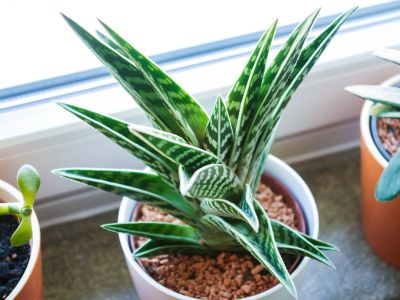Plant pigments are responsible for the coloring in these plants. Cells of chlorophyll are the primary pigment responsible for the green hue in plants. Variegation in different amounts of this chlorophyll is the cause of variegated plants.
Variegated Succulent Plants
Several species contain variegated plants, some of the most interesting and unique ones like those that are featured below. If you wish to add a variegated plant to your collection, take a look at these beauties.
Variegated Stonecrop Sedum ‘Tricolor’ features clusters of pale pink, starry type flowers in summer. This is a creeping semi-evergreen that forms a mat during the growing season.
Aloe Variegata, often called Tiger Aloe, is a smaller aloe, often growing only about 10 inches (25 cm.) tall. As a clump-former, variegated aloe is stoloniferous with leaves which terminate into a blunt point. It has a rough, textured, warty feel. Irregularly spaced oblong white crossbands spread along the leaf. It blooms in winter with spikes of bright orange flowers. The flowers have six petals and are about an inch long.
Aeonium ‘Sunburst’ has large rosettes of fleshy, variegated leaves on thick stems which are seemingly bare. Green, yellow and creamy white foliage forms coppery red tips when grown in full sun. Pale yellow flowers appear, also in mid-winter to early spring on mature plants. Growing these in the garden creates a dramatic texture. Use them in rock gardens and dry borders. As a frost-tender evergreen these thrive in sunny coastal climates. They will not survive in colder climates, so you might grow them in containers and bring them inside for cold weather protection.
Crassula Ovata also offers ornamental value as a subtropical evergreen. It is a succulent shrub native to the southern coast of Africa, featuring patchy green and white leaves.
Variegated snake plant is also known as mother-in-law’s tongue. Historically it was in the genus Sansevieria, but has been reclassified into the genus Dracaena. It is easy to grow, with 70 varieties available. Each has unique variegation specific to the plant, sometimes with black markings. These plants have various leaf structures along with different height, form and colors making many unusual varieties.
If you’re expanding your plant collection, consider these variegated types mentioned above. You could acquire beautiful specimens with unique characteristics. Fun and easy to grow, low care while they are beautiful on display.
